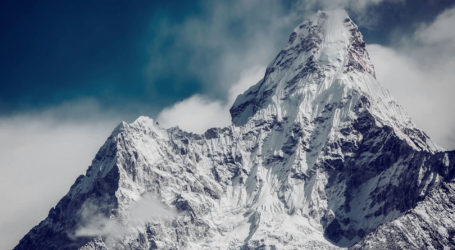The mother of all climbs
Every time I stepped outside my hotel in Zermatt there would be a gaggle of tourists holding up their phones to take a photo. Not of me, annoyingly, but of the big pointy peak rearing up into the heavens. The Matterhorn. Commission a five-year-old to draw a mountain and this is what they’ll come up with. Because this is how a mountain should look. Even if you’ve seen a thousand photos, seeing it for real, steepling above Zermatt’s chalet roofs, is powerfully exciting. Like the Taj Mahal or Petra, it doesn’t disappoint.
Most of us, however, are content to admire it from the town square or from a chairlift. Climbing the Matterhorn is a risky enterprise requiring experience and fitness, even if you hire a mountain guide. But if you’re a fit walker and want to experience some of the thrill of Alpine climbing without taking on the Matterhorn, then Zermatt is an ideal place to have a go. Some of the most accessible peaks in the Alps surround the St Nicholas valley where Zermatt nestles.
There are 82 summits in the Alps over 4,000m (13,000ft), the altitude with cachet in Europe. Easiest of them all is the Breithorn, the Matterhorn’s snowy next-door neighbour and the ideal vantage point from which to view the superstar peak. You won’t have to splash out on expensive equipment if you have a ski jacket and a warm pullover. The Breithorn requires only crampons, a climbing harness and a ski stick, equipment that can be hired easily in Zermatt for the day. The town’s guides bureau runs group tours to the summit daily in summer, weather permitting, for €103 per person. If you’ve never used crampons before, the guides are there to show you how. All they suggest is doing a few hikes beforehand to acclimatise.
The Breithorn is a big friendly giant for one reason – the cable car that runs to within 365m of its summit. Early on a June morning of threatening skies and strong winds, I found myself shouldering my way into a cabin for a ride that would lift me almost 2,300m above the valley. That’s a Ben Nevis with a Scafell Pike glued on top that my creaky knees wouldn’t have to go up and down.
Despite the bad weather and early hour, the cabin was full of middle-aged men who appeared to be greyhound fit. The Swiss tourist board, it transpired, had arranged for our ascent to coincide with the 150th anniversary of the Alpine Club, the very first mountaineering club in the world founded, rather improbably, not in the Alps, but in Ashley’s Hotel in Covent Garden.
Almost every peak overlooking Zermatt was first climbed by hyperactive Englishmen, establishment types like lawyers, dons and churchmen, accompanied by local guides picking up a little extra cash to supplement their farming incomes. In fact, the English more or less invented the whole madcap enterprise of climbing mountains for fun in the first place.
Now I found myself squeezed alongside the descendants of those pioneers, including Doug Scott, the first Englishman to climb Everest in 1975. Unlike the rest of us in our bright Gore-Tex, Scott was dressed for the elements in a waxed shooting jacket and an Aussie bush-hat.
‘You remind me of someone,’ I tell him.
‘Worzel Gummidge?’
‘Close.’
‘Michael Foot?’
‘That’s it.’
A couple of years ago I had seen Scott struggling to cross a room let alone a glacier, reduced to walking with crutches on knees ruined not by mountaineering, but from playing rugby into his 40s. Now 66, it was nice, he told me, to be climbing again without pain.
Also near at hand was Stephen Venables, the AC’s current president and the first Englishman to climb Everest without bottled oxygen, and by a new route as well. But the real eminence was George Band, one of the Everest pioneers with Edmund Hillary and Tenzing Norgay in 1953. He was also the first man to climb Kangchenjunga, the third highest mountain, two years later. Now 78, he had mustered a team to accompany him in stately grandeur to the summit.
It was a good job I was in such illustrious company. As the cable car slowed to enter the summit station, it was buffeted by strong winds and all the climbers looked doubtfully through the windows into swirling mist. As the doors opened a blast of crisp, freezing air swept round us and I zipped up my jacket.
The small team of guides keeping us safe disappeared along the tunnel leading outside to the glacier to establish if the ascent was on. It was clear that under normal circumstances and with regular clients they wouldn’t have left the valley in the first place. But given the occasion and the fact that half the party had at some point jogged up Everest, it seemed we were good to continue.
Conditions outside were bracing. The wind leant against us and thick cloud sped across the summit above. The good news was that the low temperatures had left the glacier frozen, meaning that we could walk easily on the surface rather than sink in half-melted slush. The climbing itself seemed no more difficult than walking up a steep Scottish hillside, albeit waddling like a duck to avoid tripping over my crampons.
At first the view wasn’t up to much. If you’ve seen the inside of one cloud, you’ve seen them all. But as morning wore on the wind tore holes in the grey mass, revealing a brilliant world of dazzling snow and ice and cobalt skies beyond. By the time we reached the summit, I felt wonderfully invigorated by the cold sharp air. No wonder tuberculosis sufferers got packed off to the Alps. Annoyingly, though, the peak’s celebrity neighbour remained elusive all morning, only to re-emerge as we boarded the cable car that carried us swiftly back to the valley.
Climbing mountains is the business on which Zermatt’s prosperity was founded – before the wacko English stopped by, locals sweated long hours in the fields and pastures – and the first ascent of the Matterhorn in 1865 and its tragic aftermath gave Zermatt a rather grisly unique selling point and sent its fame soaring. On his sixth attempt, Edward Whymper became the first man to reach the summit, but of the seven-strong team he led out from the Monte Rosa Hotel, only three returned. One of the dead was Lord Francis Douglas, younger son of the Marquess of Queensberry. The accident caused a scandal in the British press and became a defining moment in mountaineering history. You can see in the Zermatt museum the remnant of the rope that snapped as the doomed climbers fell. Tourists rushed to see the focus for so much obsession and tragedy. That strange combination of horror and fascination of the Matterhorn still attracts more than 2,000 climbers each year. They often have to queue to reach its summit.
But these are changing times on the mountain, as climate change takes a grip. Willy Taugwalder is a distant relative of the two guides who survived the first ascent. In the past, he says, guides wouldn’t ask clients too many questions about their previous experience, but those days are long gone. Now guides pay close attention to their clients’ skill level, asking for proof that they’re up to the climb.
‘If someone shows up and says, “I want to climb the Matterhorn,” of course you can take the guy up there, but you have to turn around so many times because they have no clue about what’s involved,’ he says. ‘They fail, they’re disappointed and they’ve paid the money anyway. So we ask them to do one training climb with us before the Matterhorn.’
The Matterhorn does not come cheap. Zermatt guides charge €793 for the nine-hour climb, with a night in the hut the night before thrown in. The required training climb will set you back another €300, and then there’s accommodation in the valley, which can be eye-wateringly expensive. Hardly surprising, then, that fewer than one in 10 ascents of the Matterhorn are made by guided parties.
Taugwalder says that newcomers to the mountain often lose the route, threatening others below when they knock off loose stones. Climate change is also having an impact. During the hot summer of 2003 a gigantic rock fall peeled off the mountain, a likely consequence of climate change. Taugwalder was working on the mountain that day and narrowly escaped. But he accepts his place of work is hazardous with or without the effects of global warming. ‘In the mountains erosion is always happening. You need luck not to be in the wrong place at the wrong time.’
Ski touring, he says, has been most affected by rising temperatures. When he qualified as a guide, he was still working into late May. Now he’s lucky to work beyond late April. ‘And the north faces are changing for sure. Ice and snowfields disappear sooner and there is more rock fall. That means you have to climb these routes in May and not in the high season.’
But overall, Taugwalder is more anxious about the state of his knees than the state of the Matterhorn. Catching a glimpse of the mountain, still caked in snow in late June, as I leave the bar where we meet, I can sympathise. One of us has a lot more time than the other.










